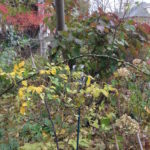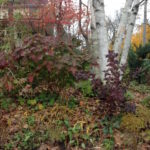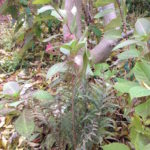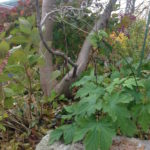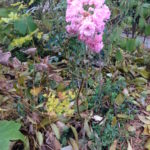Gardening constantly presents us with interesting challenges. Fifteen years ago I moved to a small property completely covered by a canopy of trees: Norway maple, birch, staghorn sumac, Eastern white pine and star magnolia. Below the trees were sparse, patches of lawn. Previously, I had ideal conditions – a sunny site with rich soil where new plants were simply plopped into the ground and magically thrived! Gardening under trees became a new, unique challenge!
Local gardeners made helpful suggestions: buy several of the same plant to try in different locations, look and learn from neighbouring gardens and search for plants that tolerate dry shade.
After years of experimental research, beautiful trees and plants now coexist harmoniously in my garden.
Specific Conditions:
The leaf canopy filters light creating dappled to deep shade and also prevents rain reaching the ground resulting in less moisture and dry soil. The roots of trees require space, moisture and nutrients. Introduced plants compete for these limited resources. It is essential to balance the health of both the trees and the plants.
Preparing Beds:
Remove grass by smothering it under newspaper/cardboard for 3 months. Do not pile up soil beyond 4” or make raised beds. Deep soil restricts oxygen to tree roots, harming the tree.
Planting Tips:
Disturb roots as little as possible. Start small. Use seedlings or small plants. Dig a small hole with a small trowel. Add compost in the hole while tucking the plant in. Do not cut larger roots; plant around roots. You can mass many small plants with this method.
Tips on Care:
Water new plantings in well; water during dry spells. Mimic natural woodland by adding 3”-4”of compost annually. Compost, well-rotted manure, leaf mould and mulch provide nutrients, moisture retention, aeration, loosened clay and drainage.
Choosing Plants:
Native woodland plants are accustomed to coexisting with trees. Try buying plants potted up out of the gardens of local gardeners. There are many local nurseries and arboreta that propagate and sell natives.
Spring Favourites:
Dry Shade:
- There are many native spring bloomers that tolerate dry shade: Canada columbine, Solomon’s seal, Jack-in-the-pulpit, bluestar, early meadow rue and Ohio spiderwort.
- Non-natives: hellebores, bleeding hearts and leopard’s bane.
- Bulbs: Many favourite spring bulbs absorb the sun before leaves appear. Dry soil prevents them from rotting.
Shade/Moisture:
- Natives: Virginia bluebells, bloodroot, mayapple, foamflower, baneberry, twinleaf, trillium, blue cohosh.
- Non-native: coral bells, corydalis, Siberian iris.
- Groundcovers: sweet woodruff, geraniums – wild and mourning widow. Non-native: barrenwort/bishop’s hat, bigroot geranium, brunnera.
- Shrubs: oakleaf hydrangea, fothergilla, ninebark, witch hazels, elderberry, yews, leatherwood, Oregon grape holly, redbud. Non-native: smoketree, boxwood, Japanese kerria.
Other Seasons
Bellflowers, hosta, asters (white wood, New England, heart-leaved), cup plant, goldenrod, Japanese windflower, fleece flower, goatsbeard, snakeroot, deadnettle, bottle gentian, masterwort, phlox, bugbane.
Grasses: bottlebrush, Japanese forest grass, Northern sea oats, switch grass.
Shrubs: dogwood, snowberry, nannyberry, spicebush, bladder nut, chokeberry, serviceberry, bush honeysuckle, smooth hydrangea.
Roses for Shade: redleaf, The fairy, rugosa, New Dawn, Iceberg.
- Birch, burning bush, magnolia, rugosa rose, smooth hydrangea, oakleaf hydrangea, boxwood, New Dawn rose branch, leopard’s bane, baneberry. Photo by Susan Mason.
- Birch, burning bush, oakleaf hydrangea, ninebark, spirea, barrenwort/bishop’s hat, coral bells, lungwort, bigroot geranium, yews, Oregon grape holly, Japanese windflower, daylilies. Photo by Susan Mason.
- Star magnolia, Japanese painted fern, mophead hydrangea, oakleaf hydrangea, sweet woodruff, boxwood. Photo by Susan Mason.
- Star magnolia, Japanese windflower, bugbane, mophead hydrangea, oakleaf hydrangea. Photo by Susan Mason.
- Sweet woodruff, Japanese windflower, The Fairy rose, hellebore, twinleaf, meadow rue. Photo by Susan Mason.
Good Gardening!
— Susan Mason, Guelph Wellington Master Gardeners
This post was first published in the Puslinch Pioneer.

